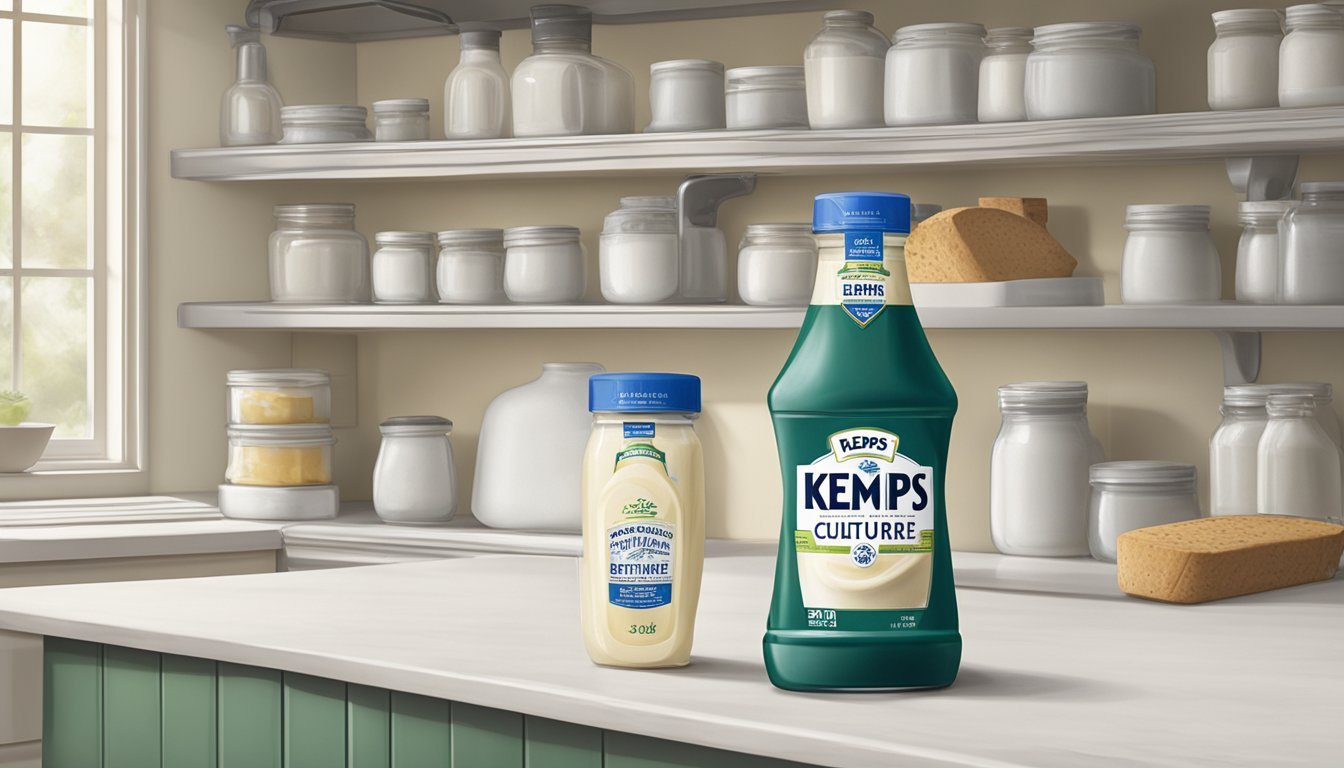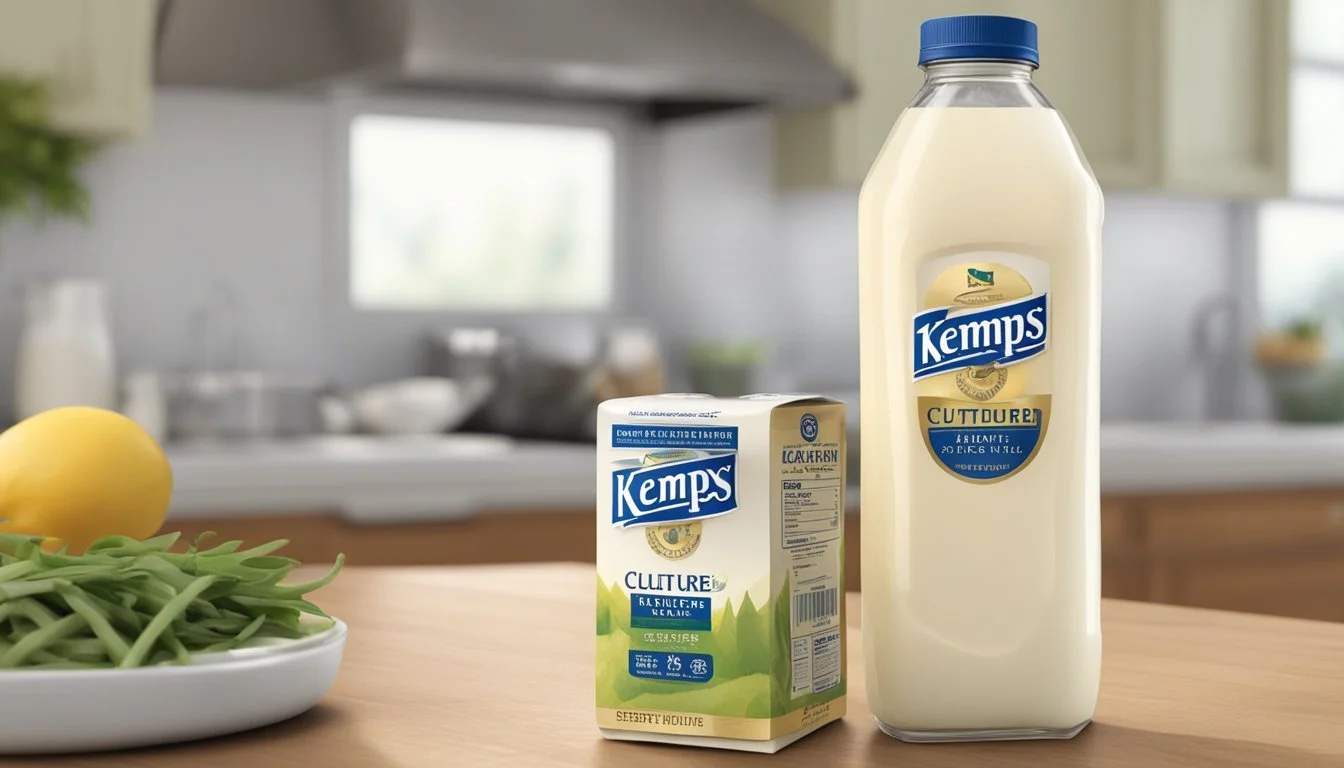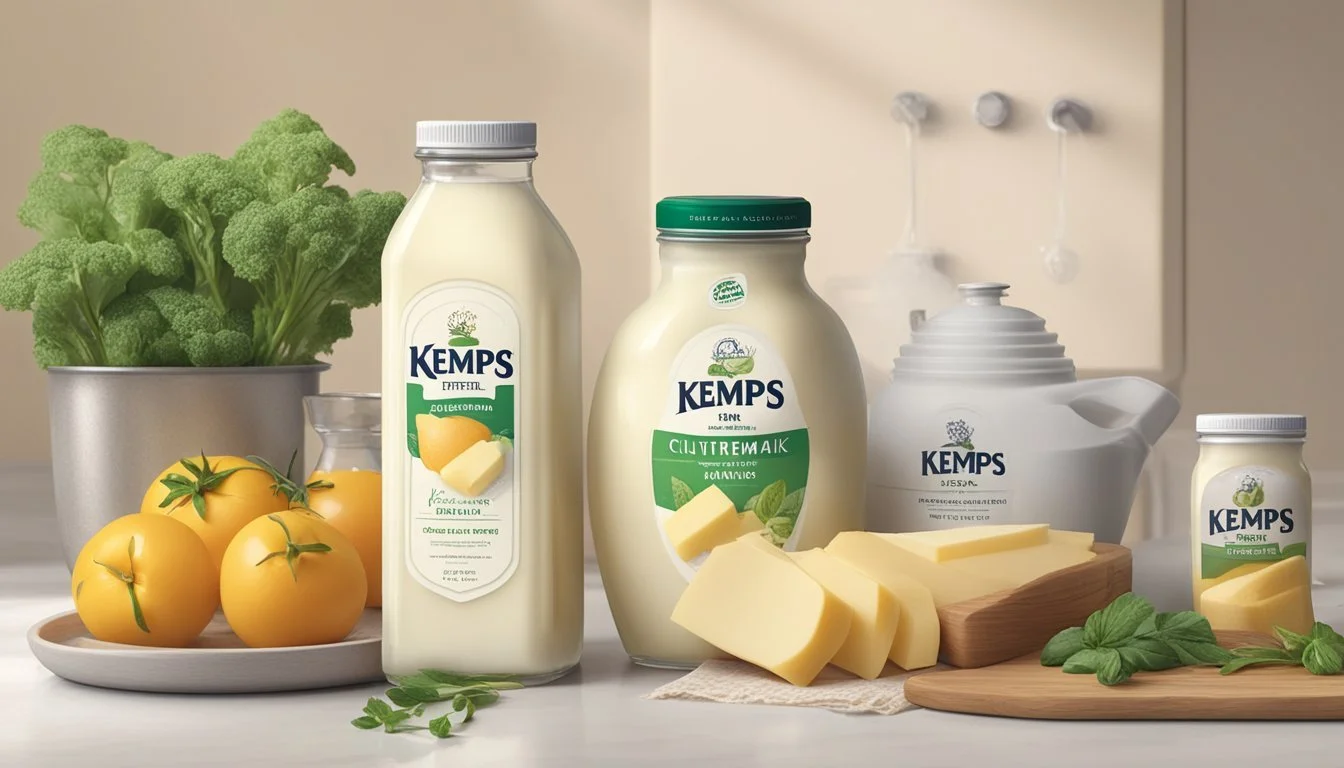How Long Does Kemps Cultured Buttermilk Last?
Shelf Life and Storage Tips
Cultured buttermilk, such as the varieties produced by Kemps, is a fermented dairy product known for its tangy flavor and thick consistency. This type of buttermilk is created through the introduction of bacterial cultures to milk, which results in a product with a naturally longer shelf life compared to its uncultured counterparts due to the preservation properties of the fermentation process.
When purchasing Kemps cultured buttermilk, consumers can expect a shelf life that typically exceeds that of regular milk. Unopened, it can last up to two weeks past its printed expiration date if kept refrigerated and stored properly. Once the seal is broken, it's advised to consume the buttermilk within 7 to 10 days to ensure quality and safety. The buttermilk should always be stored in the refrigerator in an airtight container to maintain its shelf life.
Regularly checking the buttermilk for signs of spoilage is crucial, as with all dairy products. Signs include an off smell, a change in texture, or a sourer than usual taste. If any of these signs are present, it is best to err on the side of caution and dispose of the product. Consumers can enjoy the full range of benefits that cultured buttermilk offers by adhering to these storage guidelines and freshness indicators.
Understanding Buttermilk
Buttermilk is a dairy product with a rich history and has various types, each with its own culturing process and nutritional benefits. It is widely utilized in culinary practices for its unique flavor and leavening properties.
Origins and Types of Buttermilk
Traditionally, buttermilk referred to the liquid left behind after churning butter from cream. This liquid, known as real buttermilk, contains remnants of butter and milk. However, most buttermilk found in stores today is cultured buttermilk, created by adding lactic acid bacteria, such as Lactococcus lactis, to milk. Cultured buttermilk, compared to the traditional one, offers a thicker consistency and tangier flavor.
Culturing Process
The production of cultured buttermilk involves inoculating pasteurized milk, typically whole milk or lowfat milk, with a bacterial culture. This culture converts lactose into lactic acid, thickening the milk and giving it a tangy taste. A portion of the current batch can serve as a starter culture for the next, creating a continuum of homemade buttermilk. Cultured buttermilk from companies like Kemps might include thickeners or stabilizers to improve texture.
Nutritional Profile
Cultured buttermilk is a nutrient-rich dairy product. It is comparatively high in protein and also contains calcium, vitamin A, and vitamin D when fortified. Kemps cultured buttermilk, for instance, may contain additional vitamin A palmitate and vitamin D3. Furthermore, the presence of lactic acid can make it easier to digest for individuals who are lactose intolerant.
Nutrient Benefit Protein Supports muscle repair and growth Calcium Essential for bone health Vitamin A Vital for immune function and vision Vitamin D Aids in calcium absorption and immune response
Culinary Uses
Buttermilk is a versatile ingredient in the kitchen, often used as a leavening agent in baking thanks to its acidic properties that react with yeast or other leavening agents. Its acidity tenderizes gluten, making for softer baked goods. Buttermilk also imparts a rich flavor and can be utilized in dressings, marinades, or homemade cultured dairy products.
Storage Guidelines
When it comes to storing Kemps cultured buttermilk, adhering to proper conditions is crucial to maintain its quality and safety. This section covers the optimal storage settings, common indicators of spoilage, and methods to prolong the dairy product's shelf life.
Optimal Storage Conditions
Cultured buttermilk should be stored in the refrigerator at temperatures below 40°F (4°C). It is important to keep it sealed tightly to prevent the absorption of other flavors and contamination. This dairy product is pasteurized which helps to eliminate most harmful bacteria and extends its shelf life compared to raw milk products. Nevertheless, one should always respect the expiration date provided by the manufacturer.
Signs of Spoilage
Spoilage in cultured buttermilk can be detected by:
Smell: A sour and unpleasant odor differing from the naturally tangy fragrance of fresh buttermilk.
Appearance: The presence of mold growth or any discoloration.
Texture: Any noticeable thickening or curdling beyond its original consistency could indicate spoilage.
Extending Shelf Life
To extend the shelf life of Kemps cultured buttermilk:
Freezing: One can freeze buttermilk, though it may slightly alter the texture. To freeze, pour the buttermilk into an airtight container, leaving some room for expansion. It can be stored in the freezer for up to three months.
Starter: If using buttermilk as a starter to ferment a new batch, ensure it is done with a fresh product to prevent the spread of any potential spoilage and to maintain the quality of the culture.
Using Buttermilk in Recipes
Buttermilk is a tart, tangy ingredient that is often used to enhance the flavor and texture of various recipes. Its acidity can help to tenderize meats and interact with baking soda to provide lift in baked goods.
Baking with Buttermilk
Baking aficionados often incorporate buttermilk to add a subtle, sour dimension to sweet and savory baked items. Buttermilk pancakes are a classic example where it contributes to a soft texture and a slight tanginess. When making chocolate cake, buttermilk's acidity balances the sweetness of sugar and complements the richness of chocolate, often making the cake more tender and moist. In soda bread and buttermilk biscuits, the presence of buttermilk acts as a leavening agent alongside baking soda, creating a fluffy and light crumb.
Baking Use Ingredient Interaction Result Chocolate Cake Buttermilk + Baking Soda Tender, moist crumb Buttermilk Pancakes Buttermilk + Flour Fluffy texture Soda Bread Buttermilk + Baking Soda Rise and crumb texture Buttermilk Biscuits Buttermilk + Baking Powder Light, airy texture
Non-Baking Uses
Buttermilk extends its utility beyond baking. Chefs use buttermilk for its sour profile and creamy texture in sauces and salad dressings, providing a tangy base that requires little more than an addition of herbs or spices. As a marinade, buttermilk's acidity tenderizes and infuses meat with flavor. It can also serve as a healthier alternative to sour cream or mayonnaise in dips or as a topping on baked potatoes.
Marinades: Tenderize and flavor meat
Sauces/Dressings: Base for tangy and creamy sauces (What wine goes well with creamy sauces?)
Substitutes: Alternative to sour cream or mayonnaise
Substituting Buttermilk
There may be scenarios where substitutes for buttermilk are needed, either due to dietary restrictions or lack of availability. One can mix milk with a tablespoon of vinegar or lemon juice per cup of milk and let it sit until it curdles, creating a similar tart flavor. Yogurt or kefir diluted with milk can work as an alternative as well. Chefs need to ensure that the substitute provides the necessary acidity and texture for recipes calling for buttermilk.
Vinegar/Milk Mixture: 1 tablespoon of vinegar or lemon juice + 1 cup of milk
Yogurt/Kefir: Thinned with milk to match buttermilk's consistency
Health and Nutrition
In examining the health and nutritional aspects of Kemps cultured buttermilk, it is essential to consider its macronutrient profile and how it fits into various dietary considerations.
Macronutrients and Micronutrients
Kemps cultured buttermilk is a dairy product that provides essential macronutrients and micronutrients. A serving size is typically 1 cup (236mL), and it contains 110 calories. The product comes from cultured skim milk, which is lower in fat than whole milk. For those monitoring fat intake, particularly saturated fat, it's worth noting that a serving contains about 2.5g total fat, with 1.5g of that being saturated fat. It contains 0g trans fat, which is beneficial as trans fats are associated with negative health effects.
In terms of micronutrients, the buttermilk is fortified with Vitamin A palmitate and Vitamin D3, contributing to daily vitamin requirements. It provides calcium, which is crucial for bone health. The specific amounts of calcium, vitamin A, and vitamin D—as well as other micronutrients like potassium and iron—are critical to understanding the overall nutritional value but are not explicitly stated in the provided information. However, it's generally known these are inherent components of buttermilk.
Nutrient Amount per serving % Daily Value* Total Fat 2.5g 3% Saturated Fat 1.5g 7% Trans Fat 0g 0% Cholesterol Not provided Sodium Not provided Total Carbohydrates 13g Dietary Fiber <1g Total Sugars Not provided Added Sugars Not provided Protein 9g Vitamin A Not provided Vitamin C Not provided Vitamin D Not provided Calcium Not provided Iron Not provided Potassium Not provided
* Percent Daily Values are based on a 2,000 calorie diet. Your daily values may be higher or lower depending on your calorie needs.
Dietary Considerations
Buttermilk can be a suitable inclusion in a variety of diets, being a source of protein with 9g per serving. It’s important for individuals on a low-cholesterol or low-sodium diet to check the label for specific amounts of cholesterol and sodium. As for potassium, it plays a role in various bodily functions, including blood pressure regulation, and individuals seeking a diet high in potassium would need to verify its levels in this buttermilk.
For those managing their carbohydrate intake, the total carbohydrates present are 13g per serving. The specific content of total sugars and added sugars is something consumers should ascertain from the product label to fit into their dietary management, especially for those with diabetes or those monitoring sugar consumption.
Considering dietary fiber, this buttermilk contains less than 1 gram per serving, which is minimal. Dietary fiber is beneficial for gut health and maintaining regular bowel movements, so those requiring high-fiber diets should consider other sources in addition to buttermilk.
In conclusion, Kemps cultured buttermilk provides a controlled calorie option with reasonable amounts of fat and protein, which can be included in a balanced diet. Those with specific dietary needs should consult the nutrition facts label for precise values.
Food Safety and Preservation
Proper storage and handling are crucial for maintaining the safety and extending the life of Kemps cultured buttermilk. This section tackles the specifics of freezing and thawing practices along with methods to detect and prevent contamination, ensuring the buttermilk remains safe to consume.
Freezing and Thawing Buttermilk
Kemps cultured buttermilk can be frozen to extend its shelf life. To freeze, it is advisable to use an airtight container or a mason jar, leaving some space at the top as buttermilk expands when frozen. Freezing may alter the texture due to the destabilization of the locust bean gum or carob bean gum used as stabilizers. However, frozen buttermilk is still suitable for cooked or baked dishes, like buttermilk pie.
When thawing, it's imperative to do so in the refrigerator to prevent the growth of harmful bacteria. Thawed buttermilk should be used within 24 hours and stirred well before use, as separation may occur. It's not recommended to refreeze buttermilk once it has been thawed.
Detecting and Preventing Contamination
Contamination in buttermilk can manifest as off odors, flavors, or visible mold. Such changes indicate that the product should not be consumed.
To prevent contamination, always:
Use clean utensils when pouring buttermilk.
Seal the container tightly after each use.
Store promptly in the refrigerator, as harmful bacteria grow rapidly at room temperature.
Since Kemps cultured buttermilk is a fermented product, it contains lactic acid bacteria that can inhibit some pathogens, offering a slight edge over non-fermented dairy products. Nevertheless, the pasteurization process, usually applied to buttermilk to kill harmful bacteria, doesn't make it invincible to spoilage. Consistent refrigeration after opening and consuming it within the recommended timeframe of 7 to 10 days will help maintain its safety and quality.
Buttermilk Variants and Products
In the realm of cultured buttermilk, variants such as flavored buttermilk offer a twist on the traditional, while commercial buttermilk often comes with additives like emulsifiers or thickeners to ensure consistency and shelf life.
Flavored Buttermilk
Flavored buttermilk takes the classic buttermilk base and introduces additional tastes to cater to diverse palates. In these variants, lemon or sugar may be added to create a refreshing option that pairs well with desserts. For example, lemon-flavored buttermilk can be a key ingredient in chocolate cake or coffee recipes, providing a tart contrast to the sweetness.
Commercial Buttermilk Additives
Commercial brands like Kemps fortify their cultured buttermilk with carrageenan and carob bean gum, which are common emulsifiers and stabilizers. These additives work to maintain the product's texture and prevent separation.
Carrageenan: Used in minimal quantities, it serves to maintain a smooth consistency.
Modified Corn Starch & Salt: These are added to adjust the buttermilk's thickness and flavor profile.
Apart from adding to the stability and flavor, these additives ensure that the buttermilk integrates seamlessly when used as an ingredient in dressings or as a base in a marinade where oil and aroma play pivotal roles.
Purchase and Brand Information
When purchasing buttermilk, especially Kemps cultured buttermilk, it's important to be aware of the quality of the product and to understand the nutrition facts and ingredients listed on the labels.
Identifying Quality Buttermilk
When looking for quality buttermilk, one should check for freshness and brand reputation. Kemps offers buttermilk that is a staple in dairy aisles and known for its quality. Their cultured buttermilk falls under the category of dairy products which is often used in baking and cooking recipes.
Freshness Check:
Expiration Date: Ensure that the buttermilk is within its best-by date for maximum freshness.
Appearance & Smell: The buttermilk should have a uniform consistency with no off smell, as a tangy scent is characteristic of cultured dairy products.
Understanding Labels and Brands
Consumers should read labels carefully to understand what they are buying. Below is a guide to interpreting the nutrition facts and ingredients for Kemps buttermilk.
Nutrition Facts:
Serving Size: Generally noted in cups or milliliters.
Carbohydrates: Kemps buttermilk contains around 14g per serving, with sugars making up 12g of that total.
Protein: Offers about 9g per serving, contributing to its nutritional value.
Ingredients Breakdown:
Cultured Milk: The foundational element of buttermilk which is fermented with lactic acid bacteria.
Modified Corn Starch, Salt, Carob Bean Gum, Carrageenan: These are thickeners and stabilizers used in many dairy products.
Allergens: Label includes a necessary disclaimer for milk and its derivatives.
By understanding these aspects of Kemps cultured buttermilk, consumers can make informed decisions when purchasing dairy products.






